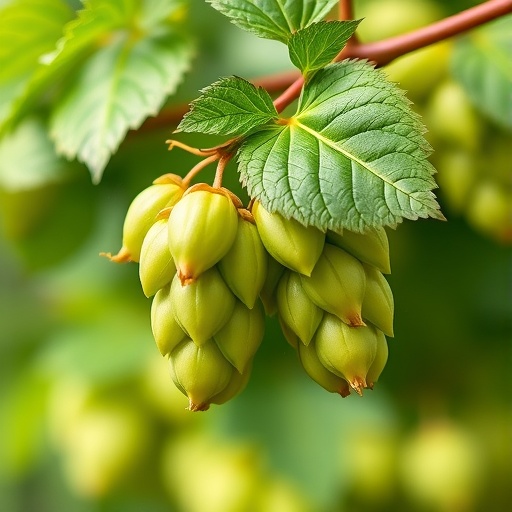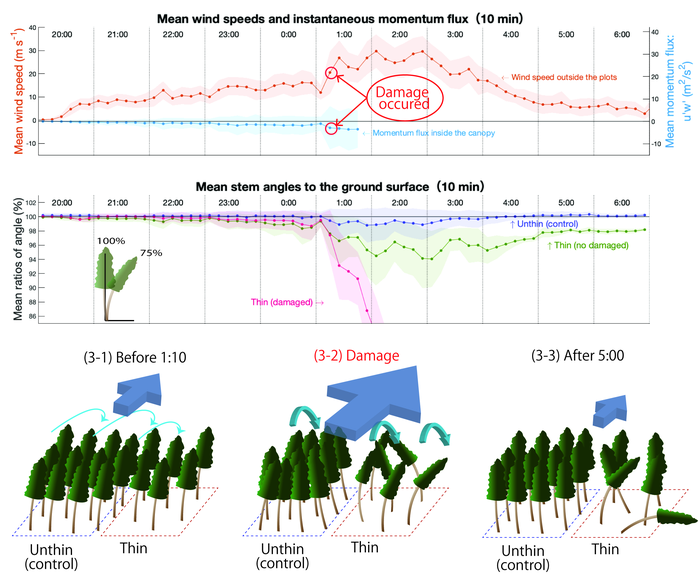
In an enthralling advancement within the realm of plant genetics, researchers have unveiled pivotal insights into the enigmatic processes governing the X–A balance sex-determining system in hops, a system distinguished by male heterogamety but markedly different from the well-characterized active-Y chromosome paradigms. This breakthrough research offers a profound glimpse into the evolutionary trajectory and mechanistic underpinnings of sex determination in plants, an area that has long lingered in the shadows compared to its animal counterparts. By dissecting the genomes of two closely related hop species, the study illuminates the intricate dance of recombination suppression, chromosome fusion, and dosage compensation that sculpt the very essence of sex chromosome function in this unique botanical context.
Sex determination across the biological spectrum manifests through a fascinating array of chromosomal systems. Among plants and animals, male heterogametic systems—where males possess differing sex chromosomes, such as XY configurations—are predominantly categorized into two broad classes: actively male-determining-Y chromosomes and X–A balance systems. While the former involves definitive Y-linked sex-determining genes that dictate maleness, X–A balance systems operate through a more complex interplay between the dosage of X chromosomes and autosomes. Although considerable strides have been made in elucidating the genetic components of active-Y systems in plants, the X–A balance mechanism has remained stubbornly elusive, constraining our understanding of its evolution and fundamental operation.
This latest study, led by a cadre of geneticists including Akagi, Segawa, and Uchida, leverages whole-genome sequencing and comparative genomics of two hop species to unravel the mysteries of the X–A balance system. These two species, evolutionarily close yet distinct, serve as a natural comparative framework to explore the ancestral and derived features of the X chromosome, including recombination dynamics and subsequent chromosomal rearrangements. The researchers meticulously charted regions of recombination suppression within the X chromosome, a hallmark of sex chromosome evolution that limits the mixing of genetic material between sex chromosomes, thereby accentuating divergence and specialization.
.adsslot_tbked0W1U8{width:728px !important;height:90px !important;}
@media(max-width:1199px){ .adsslot_tbked0W1U8{width:468px !important;height:60px !important;}
}
@media(max-width:767px){ .adsslot_tbked0W1U8{width:320px !important;height:50px !important;}
}
ADVERTISEMENT
At the heart of their findings lies an ancient event characterized by the suppression of recombination across a substantial section of the ancestral X chromosome, a feature shared by both hop species under study. This recombinational barrier effectively partitions the X chromosome into strata, reflecting sequential evolutionary stages where recombination ceased. Such strata formation is a classic signature in sex chromosome evolution, providing molecular breadcrumbs that trace the history of chromosome transformation and functional differentiation.
In a striking evolutionary twist, one of the hop species experienced a fusion event where an autosome—generally a non-sex chromosome—became integrated into the existing sex chromosome architecture, thus creating what is termed a “neo-X.” This chromosomal fusion is not merely a structural curiosity; it set the stage for additional suppression of recombination within the neo-X, catalyzing the emergence of two distinct evolutionary strata with varying degrees of genetic degeneration. Degeneration here refers to the progressive loss of gene function and accumulation of mutations typically observed in sex chromosomes due to recombination suppression.
The consequences of these sequential recombination suppression events reach far beyond chromosome morphology—impacting gene expression regulation through the evolution of dosage compensation mechanisms. Dosage compensation serves to equilibrate gene expression levels between sexes despite differences in sex chromosome copy number. Intriguingly, the two evolutionary strata on the neo-X evolved dosage compensation strategies to differing extents. The researchers adeptly linked these varying compensation levels to distinct patterns of histone modifications, a key class of epigenetic markers influencing chromatin structure and gene accessibility.
Histone modifications such as methylation and acetylation dynamically orchestrate the chromatin environment, playing instrumental roles in transcriptional regulation. By correlating differential histone marks with strata-specific dosage compensation, this study provides compelling evidence that epigenetic mechanisms are finely tuned evolutionary responses to the challenges posed by sex chromosome differentiation. Such findings not only underscore the plasticity of gene regulatory networks but also suggest a complex interplay between chromosomal evolution and epigenetic remodeling.
Beyond structural and regulatory revelations, the study delivers a molecular candidate potentially central to sex determination itself—an X-specific ETR1-like ethylene receptor localized within the ancestral X chromosome region. Ethylene, a plant hormone with far-reaching roles in growth and development, has previously been implicated in sex expression modulation in some dioecious species. The identification of this receptor gene on the X chromosome hints at a sophisticated dosage-dependent counting mechanism intrinsic to the X–A balance system, where the quantity and presence of certain gene products modulate sexual fate in a manner yet to be fully delineated.
This discovery invites a reevaluation of sex determination paradigms in plants by highlighting how hormone receptor dosage dovetails with chromosomal constitution to mediate sex expression. It also resonates with the broader biological principle that sex determination is not merely a binary genetic switch but a nuanced, multi-layered process integrating genetic, epigenetic, and hormonal signals. The hop system thereby emerges as a compelling model anchoring future explorations into plant sexual differentiation.
Crucially, the insights gained from this research shed light on long-standing questions about how sex chromosomes, especially those not governed by overt Y-linked male-determining factors, evolve and maintain stable sex determination systems. Understanding the dynamics of recombination suppression and the resulting gene decay provides essential context for the persistence of these chromosomes despite apparent evolutionary vulnerabilities. Moreover, by elucidating dosage compensation tailored to strata-specific degeneration, the study expands the conceptual framework of sex chromosome biology beyond traditional animal-centric models.
The evolutionary intricacies observed in hop species likely mirror broader patterns in plant sex chromosome evolution, especially within dioecious taxa that utilize X–A balance systems. This study, therefore, paves the way for comparative botanical genetics, encouraging parallel investigations into other plant lineages and their sex determination mechanisms. Decoding such systems might yield profound implications for plant breeding, ecology, and evolutionary biology.
From a technical perspective, the application of high-throughput sequencing and comparative genomic analyses provided a granular view of chromosomal architecture, revealing subtle yet consequential genetic rearrangements. The identification of recombination suppression regions, evolutionary strata, and their associated epigenetic landscapes required integrative bioinformatic pipelines and sophisticated chromatin analyses. These methodological approaches exemplify the power of contemporary genomic technologies to decipher complex biological phenomena that were previously inaccessible.
Furthermore, the cross-species comparison highlights evolutionary plasticity within closely related taxa, illustrating how chromosomal fusions and subsequent genomic remodeling can rapidly remodel sex determination frameworks. Such evolutionary experiments in nature offer invaluable reference points for synthetic biology and genetic engineering endeavors aiming to manipulate sex determination pathways for agricultural or horticultural purposes.
This paradigm-shifting work not only advances fundamental science but carries potential translational applications. Understanding the genetic and epigenetic basis of sex determination in hops, an economically important crop valued for its role in brewing and pharmacology, could inform breeding programs aimed at optimizing desirable traits linked to sex phenotype. Additionally, unraveling the underlying biology opens avenues for controlled sex manipulation, which could enhance yield and quality.
In conclusion, the exploration of the hop X–A balance sex-determining system through genomics, epigenomics, and molecular biology represents a landmark achievement in plant genetics. By demystifying the evolution of recombination suppression strata, epigenetic dosage compensation, and identifying candidate sex-determining genes, this study not only fills critical gaps in our comprehension of plant sexual biology but also refines overarching models of sex chromosome evolution. As research progresses, the hop system promises to illuminate the interplay of chromosomal dynamics and hormonal signaling in shaping sexual dimorphism across the plant kingdom.
Subject of Research: Evolution and mechanism of the X–A balance sex-determining system in hop species
Article Title: Evolution and functioning of an X–A balance sex-determining system in hops
Article References:
Akagi, T., Segawa, T., Uchida, R. et al. Evolution and functioning of an X–A balance sex-determining system in hops. Nat. Plants (2025). https://doi.org/10.1038/s41477-025-02017-6
Image Credits: AI Generated
Tags: chromosome fusion in plant geneticscomparison of Y-linked and X–A systemsdosage compensation mechanisms in plantsevolutionary trajectory of sex chromosomesgenetic components of sex determination systemshops genome analysisinsights into plant reproductive biologymale heterogamety in plantsplant genetics and sex determinationrecombination suppression in hopsunique sex determination mechanisms in botanicalsX–A sex determination in hops






